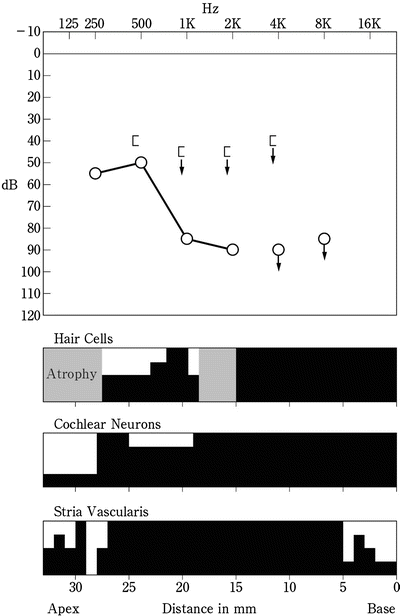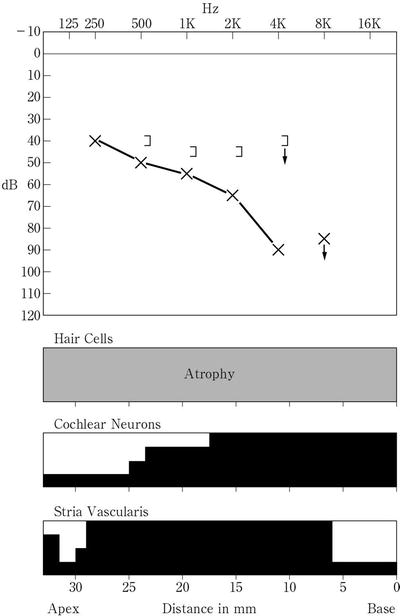, Yasuya Nomura2 and Yasuya Nomura3
(1)
The Society for Promotion of International Oto-Rhino-Laryngology, Tokyo, Japan
(2)
The University of Tokyo, Tokyo, Japan
(3)
Showa University, Tokyo, Japan
Abstract
Sensorineural hearing loss of sudden onset may occur without apparent cause. In these cases it is essential to explore underlying diseases. The term “sudden deafness” has been used in two ways: either as a description of symptoms, or to mean idiopathic sudden deafness in which clinical examinations fail to find the cause. In patients with idiopathic sudden deafness, hearing may return spontaneously, or by treatment, may fail to return with treatment, or may show varying degrees of partial recovery. This chapter discusses causes of sudden deafness related to the histopathology of the tectorial membrane. In cases where histopathology points to viral infection as the cause, the clinical diagnosis of idiopathic sudden deafness changes to viral labyrinthitis. Asymptomatic mumps should be considered in cases of sudden deafness. Three studies evaluated IgM levels in patients with sudden deafness and found that 5–7 % were affected by asymptomatic mumps. Histopathological studies of the temporal bones from patients with sudden deafness are essential, but new approaches are needed for more complete understanding of the condition.
Keywords
Asymptomatic mumpsCochlear neuronitisRelapsing polychondritisSudden deafnessTectorial membraneViral labyrinthitis4.1 Histopathology of Sudden Deafness
Several diseases are known to cause sudden deafness as a symptom.
Idiopathic sudden deafness occurs without apparent cause and is unique in that hearing loss may be restored. According to the systematic review of Chau et al. [1], the suspected etiologies for patients suffering from sudden sensorineural hearing loss included idiopathic (71.0 %), infectious disease (12.8 %), otologic disease (4.7 %), trauma (4.2 %), vascular or hematologic disease (2.8 %), neoplasia (2.3 %), and other causes (2.2 %). If we could assess the cause of sudden deafness with histopathology, fewer cases would be labeled idiopathic.
There are many limitations to using temporal bone histopathology to determine the true etiology or pathology of sensorineural hearing loss. The findings may not represent the features of the disease, because of the long interval between the onset of disease and histopathological exam. Affected cells may degenerate and disappear. The repair process may have occurred and not be ongoing. Furthermore, in the time between the onset of sensorineural hearing loss and death, life-style related diseases and the aging process will definitely progress in the inner ear. Nevertheless, temporal bone studies may reveal elements of the etiology of the disease. Conversely, these studies may reveal nothing but normal findings. In these cases, more advanced methodology is needed to elucidate the cause of disease.
Cases of sudden deafness show similar histopathological findings to cases of viral labyrinthitis, i.e., atrophy of the organ of Corti, shrinkage of the tectorial membrane, and loss of hair cells. Pathological findings are restricted mainly to the cochlea and saccule. The utricle and semicircular canals show either mild or no changes.
Schuknecht and Donovan [2] compared the pathologic findings in 12 ears with sudden deafness to those found in known cases of viral labyrinthitis caused by mumps, measles, rubella, and herpes zoster oticus. They found similar changes, especially in cases of mumps and rubella. This similarity is quite understandable because 5–7 % of patients with sudden deafness actually have mumps. This will be discussed further in this chapter and in Sect. 6.3, Mumps.
4.2 The Tectorial Membrane
Histopathology of the temporal bones in cases of sudden deafness often shows marked changes of the tectorial membrane. The tectorial membrane is generally detached from the surface of the organ of Corti in normal temporal bone cases, even when they are well preserved. Postmortem autolysis and the effects of aging are less pronounced in the tectorial membrane than in the other cells of the cochlea. This difference is because of the paucity of cellular components in the tectorial membrane, whose major components are fibrils and non-fibrillar matrix [3].
One commonly seen change in patients with viral diseases such as measles and mumps is “rolled-up” of the tectorial membrane. Rolled-up of the tectorial membrane is also reported in cases of sudden deafness, although not all cases show this change. The rolled-up tectorial membrane is covered by a single cell layer, indicating that this change did not occur postmortem (Figs. 4.1 and 4.2). Another common finding in patients with viral disease is loss of the interdental cells.
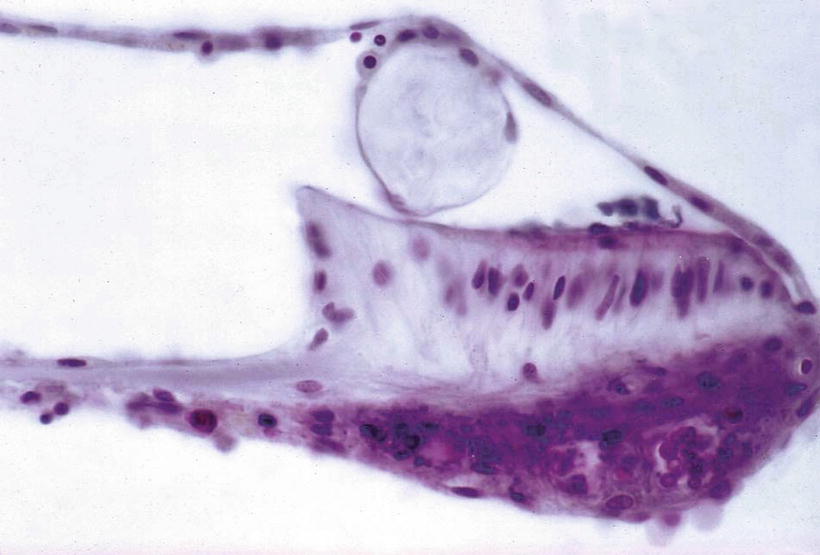
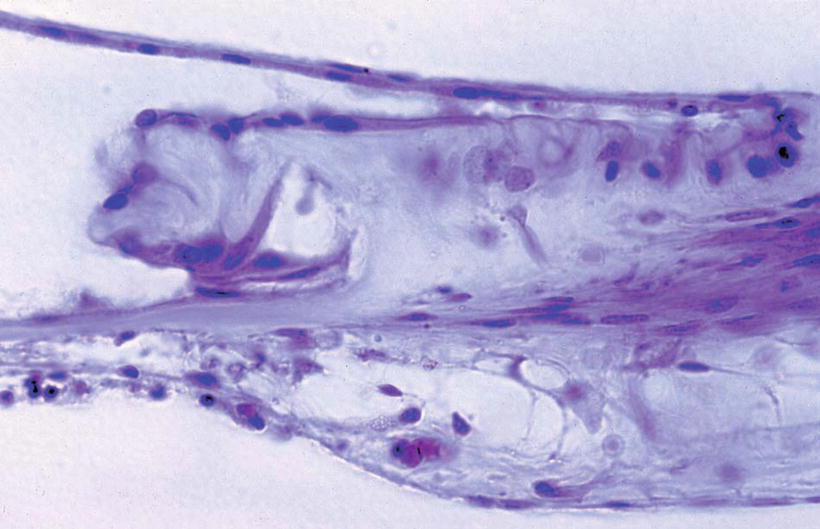

Fig. 4.1
Rolled-up tectorial membrane in a case of sudden deafness. The membrane surface is covered by a single cell layer. Loss of interdental cells is evident (Courtesy of Dr. Schuknecht)

Fig. 4.2
Drooped and cohered tectorial membrane. The membrane is covered by a single layer of cells. The inner sulcus cells and interdental cells are missing. No nerve fibers are present in the osseous spiral lamina (Courtesy of Dr. Schuknecht)
If the rolled-up change is caused by viral infection, we expect to induce similar changes in experimental animal models. In a study using guinea pigs, human herpes simplex virus (HSV type 1) was inoculated into the tympanic cavity or scala tympani of the basal turn of the cochlea. Inflammation occurred in the scala tympani of the basal turn, with less inflammation toward the apex. No cell infiltration was observed in the scala media. The tectorial membrane showed the rolled-up changes. HSV viral antigen was detected using a fluorescence method. Positive fluorescence was found within the tectorial membrane as well as in the interdental cells (see Fig. 6.6) [4]. Other changes observed in the tectorial membrane after HSV inoculation were formation of large and small bulges on the membrane surface. Electron microscopic studies revealed virus particles approximately 10 nm in diameter within and around the bulges [5]. The contour of the dips in the imprints of the tectorial membrane demonstrated collapse or fusion [6].
4.3 Case Reports
4.3.1 Case 1
The tectorial membranes of a patient with bilateral sudden deafness showed marked changes [7].
A 46-year-old woman was astounded to learn that her three sons were drafted into the army on the same day in 1942. She noticed tinnitus in both ears before long, and developed bilateral hearing loss in the night, followed by vertigo. She stayed in bed for 1 month. In 1969, testing revealed hearing loss of 78 dB in the woman’s right ear, and loss of 56 dB in her left ear (Figs. 4.3 and 4.6). In 1973, at the age of 77, the patient died by choking on phlegm.
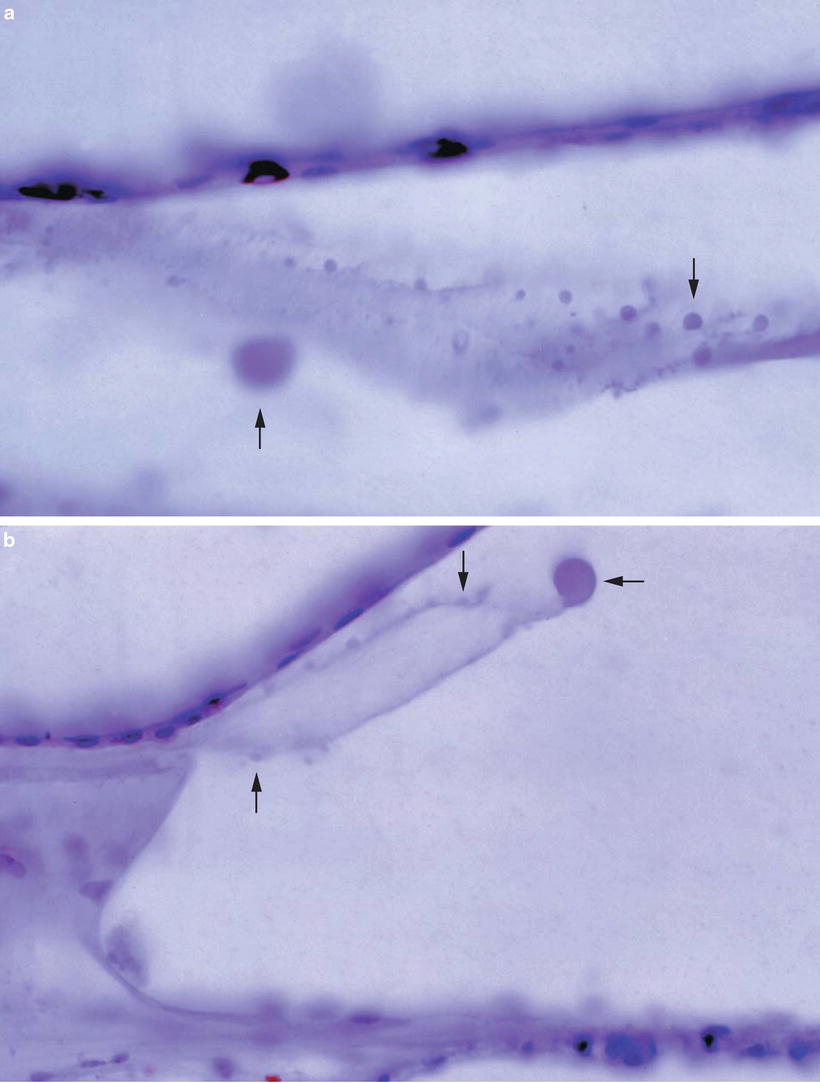

Fig. 4.4
Particles dotting the surface of the tectorial membrane of the right ear (arrows). (a) A larger mass is seen on the membrane’s undersurface. (b) A larger mass is seen at the tip of the marginal zone. Small particles are seen on the surfaces of the tectorial membrane. The interdental cells and inner sulcus cells are missing [7]
4.3.1.1 The Right Temporal Bone
Pathological changes were found in the patient’s cochlea and saccule. The lower basal turn of the organ of Corti was missing, and the upper basal turn had atrophied. In the middle turn, the inner and outer hair cells were partly missing and those remaining showed varying degrees of degeneration. The apical turn of the organ of Corti was atrophic.
The cochlear neurons were almost completely absent in the upper middle and basal turns. Twenty-five percent of neurons remained in the lower middle turn, and 75 % remained in the apical turn. The stria vascularis was atrophic and flat.
The tectorial membrane showed peculiarities in the basal turn. Many spherical structures, 3–4 μm in diameter, dotted both sides of the surface of the middle zone. At the tip of the marginal zone and the undersurface of the middle zone a larger round mass 15 μm in diameter was observed. The mass was located in the area between 10 and 15 mm from the basal end (Fig. 4.4a, b).
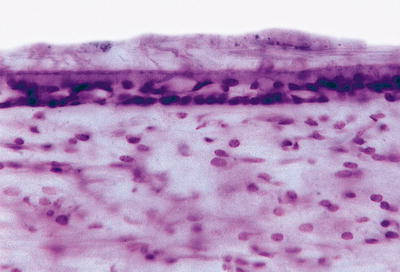

Fig. 4.5
Marked degeneration of the sensory epithelium and otolithic membrane of the saccule. No nerve fibers are observed beneath the sensory epithelium. Case 1, ×40
4.3.1.2 The Left Temporal Bone
The organ of Corti was atrophic throughout all turns. The cochlear neurons were almost completely absent from the basal end up to the 17 mm area. The intraganglionic spiral bundle was missing in Rosenthal’s canal. The stria vascularis was completely atrophic with the remnant of a thick-walled capillary. The spiral ligament was atrophic (Fig. 4.7).
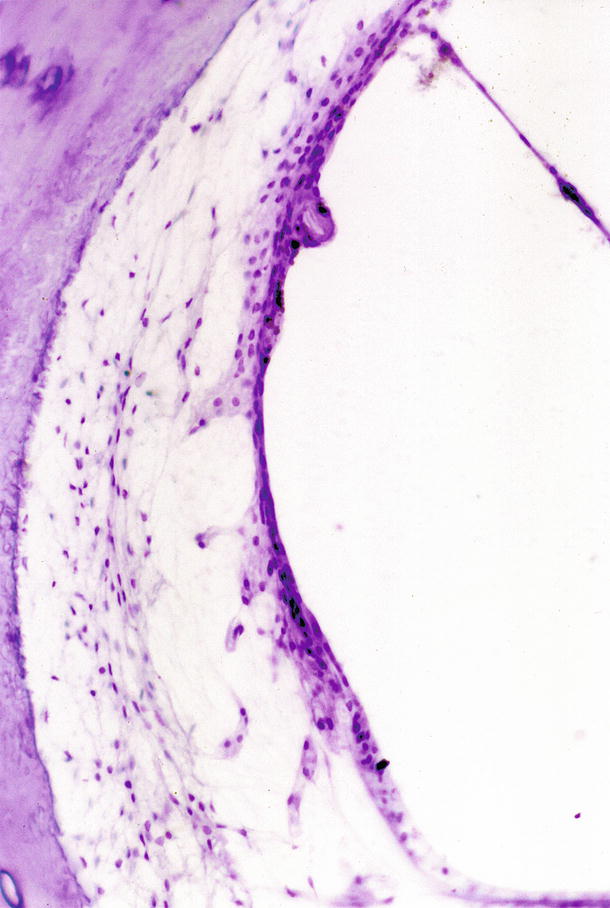

Fig. 4.7
Atrophy of the stria vascularis and spiral ligament. A thick-walled capillary remains in the atrophic stria. Case 1, left ear, ×40
The middle and marginal zones of the tectorial membrane drooped from the basal end up to the 10 mm area. A teardrop-shaped mass was attached to the undersurface of the membrane. In the 10–15 mm area, the thin limbal zone of the tectorial membrane was elevated by a cushion-like mass (18 μm thick) on the limbus (Fig. 4.8). The interdental cells were missing. From the 15 mm area to the apical end, the tectorial membrane was atrophic and flat, and adhered tightly to Reissner’s membrane (Fig. 4.9a, b). No marked changes were seen in the utricle, saccule, or semicircular canals except for decreased neuroepithelium.
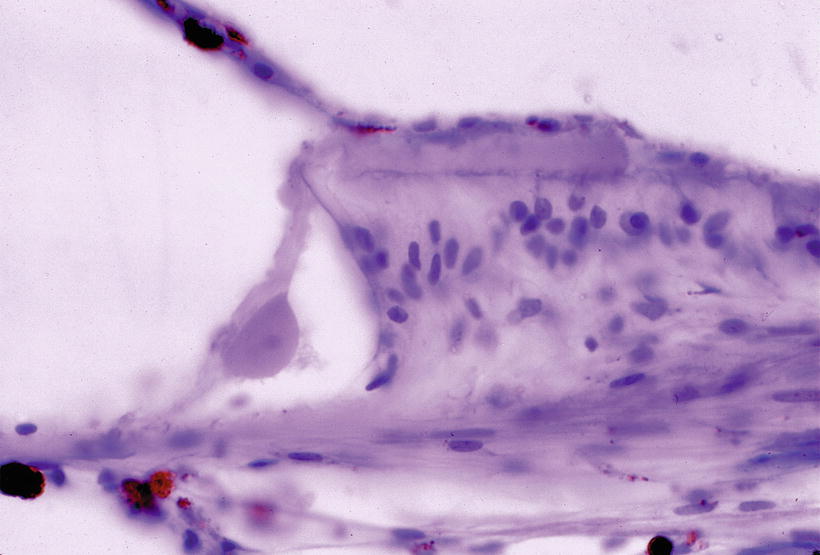
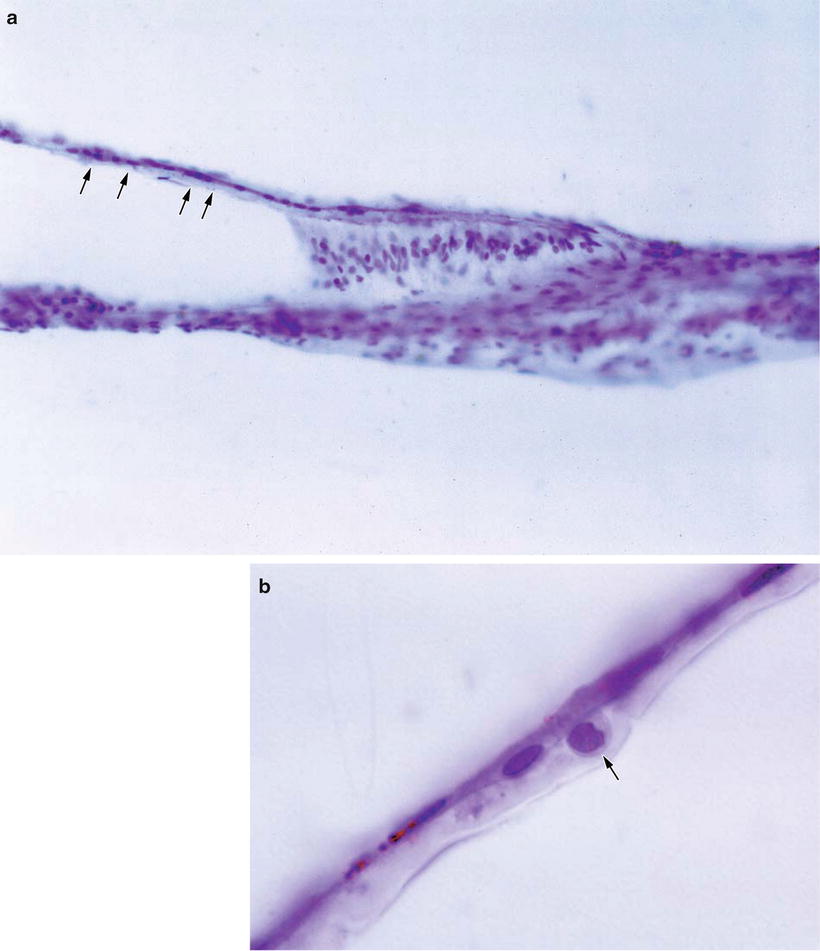

Fig. 4.8
Thickening of the limbal zone of the tectorial membrane. A teardrop-shaped mass is attached to the middle zone. Loss of interdental cells is evident. No nerve fibers are observed in the osseous spiral lamina. Case 1, left ear, ×40 [7]

Fig. 4.9
(a) Flattened tectorial membrane attached to Reissner’s membrane (arrows), apical turn (Case 1). (b) A histiocyte lies between the tectorial membrane and Reissner’s membrane (arrow). Left ear [7]
The pathological changes observed resulted from a combination of disease, repair, scarring, aging, and artifacts. Therefore, their interpretation needs deliberation. Because the tectorial membrane has no cellular element, changes caused by disease may persist unchanged for a long time. Although the rolled-up change was not found in this case, the many small particles on the surface of the tectorial membrane and the spherical substance at the tip of the right temporal bone resemble findings observed in experimental viral labyrinthitis of herpes simplex (see Fig. 6.7). The tectorial membrane of this patient’s left ear was different from that of her right ear. Separation of the components of the membrane and loss of the interdental cells were common to both ears.
Stay updated, free articles. Join our Telegram channel

Full access? Get Clinical Tree



